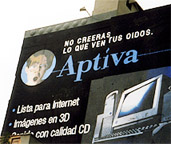
Mexico City, Mexico
(photo credit: Roland Soong)
The Technology Elite of Latin America
Part 1: Definition
For the purposes here, we are thinking about 'technology' as technological systems owned and/or operated by consumers for a variety of purposes. A consumer may use many technologies for various purposes, and we will list some of them below with examples:

Mexico City, Mexico
(photo credit: Roland Soong)
None of these technologies come for free. In fact some of them (such as personal computers) may be quite expensive to acquire and operate. Access to these technologies may be inhibited for many reasons:
Since access to these technologies is not universal, this means that there is a technology elite in Latin America which have greater access than the rest of the population. This is not a problem that is confined to Latin America alone (see the reference to Schiller's book at the bottom of this page). Within the First World, there are also identifiable groups of technology elites.
We will now attempt to make a formal definition of the technology elite in Latin America. To begin with, we realize from our initial list of examples that there are different types of technologies, with different costs and serving different purposes. This suggests that we will need a composite scoring scheme. In the table below, we have constructed a point-assignment system by which we assign points or weights to different types of technology. We chose these point values after considering the relative costs as well as our subjective importance ratings. The theoretical maximum is 99 points. It is unlikely for someone to achieve this maximum, as some of the items are possibly exclusive with respect of each other (e.g. DTH satellite versus SMATV).
|
Point Assignment System to Calculate Technology Score |
| Component | Assigned Points |
| Automobile | 12 |
| Personal Computer | 10 |
| Direct-to-Household (DTH) satellite tv dish | 8 |
| Internet access at home | 8 |
| Cellular telephone | 8 |
| Wired telephone | 7 |
| Camcorder | 5 |
| Motorcycle | 4 |
| Fax machine | 4 |
| Refrigerator | 3 |
| Clothes washer | 3 |
| Clothes dryer | 3 |
| Dishwasher | 3 |
| Computer printer | 3 |
| Stereo system | 3 |
| Satellite Master Antenna Television (SMATV) | 3 |
| Videocassette recorder | 2 |
| Video game system | 2 |
| Color television set | 2 |
| Compact disc player | 2 |
| Electronic organizer | 2 |
| Radio set | 1 |
| Calculator | 1 |
We applied this point-scoring system to the Los Medios y Mercados de Latinoamérica 1998 study. As a reminder, this classification system is applied at the household level, and not to individual persons. The actual technology scores range from 0 to 73, with a mean value of 18. In the graph below, we show the histogram of the technology scores.
Frequency Distribution of
Technology Scores

(source: Los Medios y Mercados de Latinoamérica 1998)
The technology elite is the top echelon of the technology scores. For an exact definition, we have to select a threshold. This cutoff point is arbitrary to some extent, as we can see that the distribution is continuous. For our purposes, we define the technology elite to be the top 10% of the scores. This corresponds to a cutoff value of 36 points or more.
One of the constant issues in debates about economic growth is the role of income inequality. Here, we can extend the debate to technological inequality, which is becoming increasingly important as economies attempt to move from the agrarian, past the industrial, to the information age. The standard arguments against inequality can be divided into two types:
Inequality is cause for concern for reasons
of ethics, morality and social justice. If such inequality arose
solely from personal preferences and choices about education, work and
savings, this would not be such a problem. But inequality becomes an ethical
matter when the conditions that cause them are not the due to the
individuals, but to circumstances beyond their control (such as restricted
access to education) or a legacy of historical problems (such as
exploitation and corruption).
Inequality is cause for concern to macroeconomists because of the connection between economic growth and equity. Gross inequality can weaken the pace of economic growth for many reasons. First, inequality causes social and political tensions that lead to political instability (e.g. the impact of the Zapatista uprising in Chiapas, Mexico upon the exchange rate) and inhibits capital investments and accumulation. Second, families with limited resources are unable to invest in education and training, even if such efforts may be socially and economically profitable; rather, they may prefer to have more children, thereby reinforcing the vicious cycle of inequality. Third, economic growth depends on internal consumer demand. So long as the majority of the population is living below the poverty line, the size of the economy is limited this way.
If we regard the technology scores as representations of assets of technology, we can speak of the amount of assets owned by this technology elite. In the present case, we find that this top 10% technology elite account for 28% of the technological assets in Latin America. This level of concentration is less than those that exist for income distributions in some Latin American countries. However, we need to be careful about our interpretation, as we need to distinguish ownership of consumer entertainment technologies (such as video-cassette recorders) versus business productivity and knowledge tools (such as personal computers), as the latter translates to controlling power in an information economy.
We will deal with the detailed characteristics of the technology elite in the other sections listed below.
OTHER DISCUSSIONS ABOUT THE TECHNOLOGY ELITE OF LATIN AMERICA
BOOK REFERENCES
WWW REFERENCES
(posted by Roland Soong on 1/14/00)
(Return to Zona Latina's Home Page)